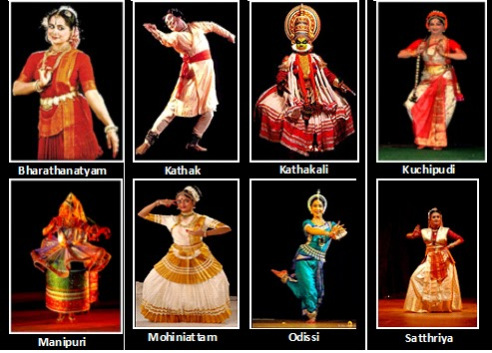The physical expression of the emotive content of the music. “Gestures coupled with rhythmical movements to expressions can be defined as Dance”. Expression of mind through body movements. In ancient culture, dance was purely for religious practices, in modern society-for entertainment.
The pleasure of dancing is in watching that music through the visual expression. Literary work which gives information about ‘Natyasasthra’ by Bharata muni. Dancing is one of the most ancient arts in Indian Culture. From as early as the Vedic times, it is established its root in the Indian soil, being deeply associated with religious rites, representing the supposed performances of the gods and goddesses themselves, and maintain the divine and spiritual concepts of the race. Aesthetic values were inherent in the styles, modes, and forms of dances.
The religious purpose being diverse, the styles of dance were equally varied. Over time secular dancing also came to establish itself. But as an art, it could not be taken lightly. The artists, male or female, had to undergo rigorous training to be well versed in the rules and formalities of any style of dance. There are two categories of Dances, the first classical dances and the second is folk dances.
Techniques of Dance
According to Sangeetharatnakara and Abhinayadarpana, dancing has 3 parts-
- NATYA – corresponds to drama.
- NRITT – pure dance – the movement of the body does not express any mood and does not convey any meaning.
- NRITHYA or Abhinaya – Along with NATYA.
Bharatnatyam: The oldest classical form
It is the oldest classical dance form of all dance forms. Bharatnatyam derives its name from Bharatamuni and Natyam which means dance in Tamil.
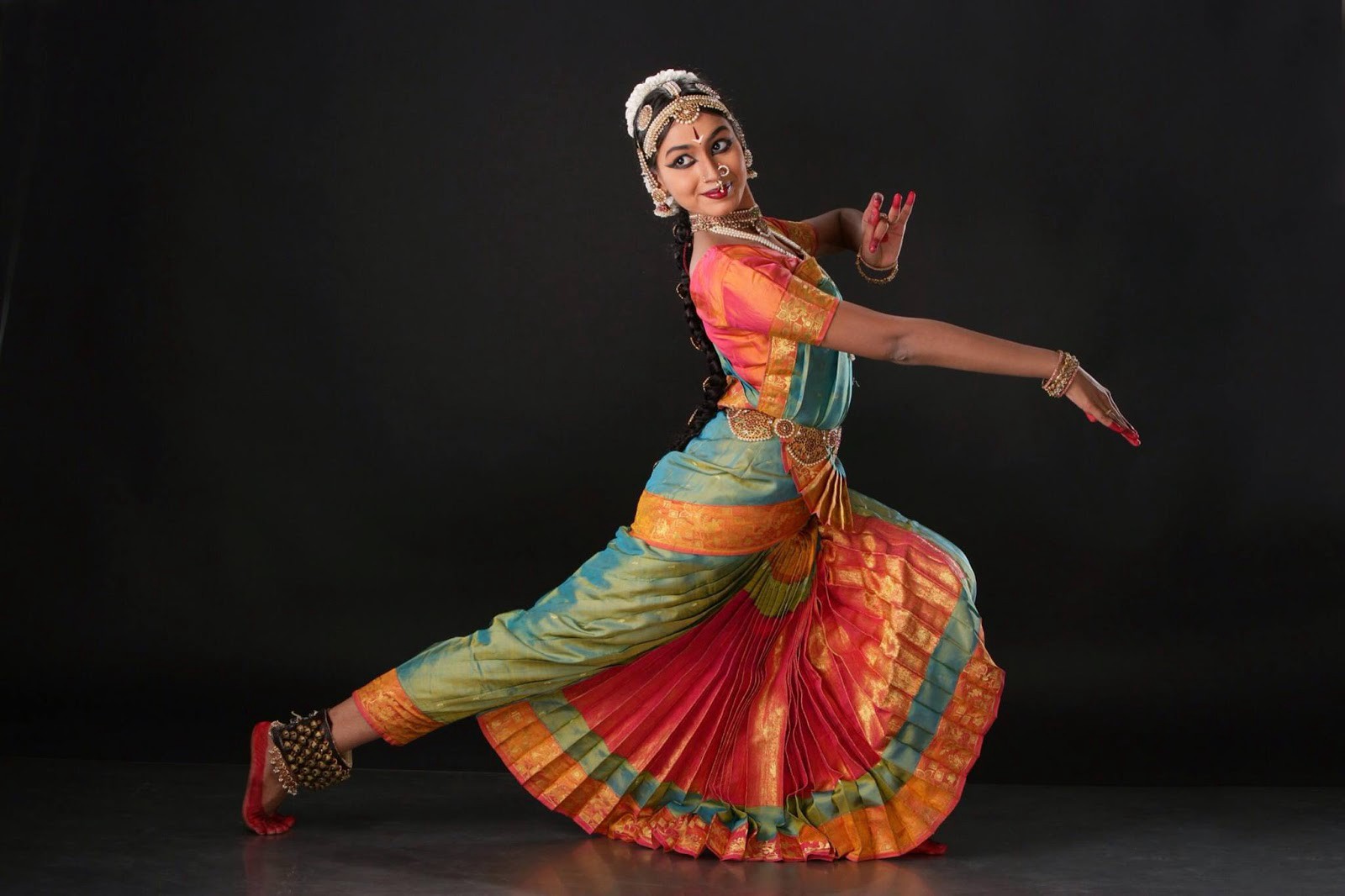
The origin of this dance is traced to the solo dance performance of Devadasis (Temple dancers) in Tamil Nadu. The art became nearly extinct after the decline of the devadasi system. The efforts of prominent freedom fighter E.Krishna Iyer revived this dance form. Movements of Bharatnatyam resemble that of the dancing flame.
Rukmini Devi Arundale, a famous proponent of Bharatnatyam bought global recognition for this dance form. She bought radical changes in the costumes of dancers.
Classification of Bharatnatyam
Alarippu: It is the beginning of dance with simple posses and movements. It seeks to get a blessing from God. It helps the dancer to get ready for the performance.
Jatishwara: It is the pure form of dance in which body movements are synchronized with the Swara of Raga and Tala.
Shabda: It includes Abhinaya in the song which generally praises the glory of God.
Varnam: Dance and emotions synchronized with Raga and Tala.
Padam: It is a mastery over Abhinaya expressed by the performer.
Jawali: Short love-lyrics performed at a faster tempo.
Thillana: It is the last stage of performance which comprise of pure dance, high spirited body movements, and complicated variation in rhythm.
Kuchipudi: The advent of Bhagavatism
Kuchipudi was originally performed by a group of actors going from village to village known as ‘Kusselavas’. Kuchipudi derives its name from the Andhra village called Kusselavapuri.

The advent of Bhagavatism made the dance a monopoly of male brahmins and began to be performed at the temple. The recital is based on Bhagavata Purana but has a secular theme and dancers came to be known as Bhagathalus. Kuchipudi became prominent under the patronage of Vijayanagara and Golconda rulers. Kuchipudi consists of divisions such as Adavus, Jatis, Jatiswara, Tirmanas, and Thillanas. The dance also expresses through Padas, Varnas, Shabdas, and slokas. These features are also found in Bharatnatyam.
Lasya and tandava elements are important in the Kuchipudi dance form. The dance style is a manifestation of earthly elements in the human body. The dancer may undertake the role of the singer as well as becoming a dance-drama performance. The music of dance is Carnatic. Lakshmi Narayana Shastri bought renown to Kuchipudi dance form. In the present century, Kuchipudi is changing its character greatly to solo items.
Kathakali: The dance form of Kerala
Kathakali is a dance form of Kerala. It derives its name from Katha’ means story and ‘kali’ means drama. The fold traditions, Ramanattam and Krishnanattam performed in temples under the patronage of feudal lords became the source of Kathakali. Kathakali declined after the breakdown of the feudal lords. Later renowned Malayali poet Vallathol Narayana Menon revived it under the patronage of Mukunda Raja. He established Kerala Kala Mandalam for the progress of Kathakali. Kathakali is a dance-drama where the actor does not speak their lines.
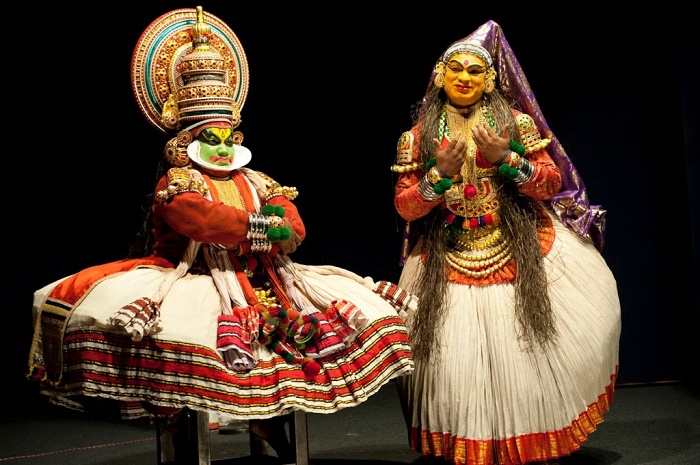
It is performed in an open-air theatre or temple premises. A brass lamp is used for lighting. Kathakali depicts the eternal conflict between Good and Evil in most of its presentations. Representation of Rasa through the movement of Eye and Eyebrows is the most remarkable feature of Kathakali. This needs strenuous training to perform. Malayalam with many Sanskrit words is the language used in Kathakali songs.
The Mask like elaborate facial makeup is governed by the complex symbolism of color, line, and design. Reddening the white portion of the eye is a peculiar feature of Kathakali. Each character like Heroes, Anti-heroes, Villains, Demons, Snags, and King have a prescribed makeup and costume. A combination of color determines the type and mood of the character in the play. These are Pacha, Katti, Thaadi (Velupu Thaadi, Chuvap Thaadi, Karup Thaadi). Green is associated with Good, red with valor and ferocity, black with evil and primitiveness, and white with purity. Guru Kunchu Kurup, Gopi Nath, Rita Ganguly, etc are the famous proponents of Kathakali.
Mohiniyattam: The Feminie Dance form of Lord Vishnu

Mohiniyattam is a classical dance tradition of Kerala which gained prominence under the rulers of Travancore. After a period of decline, it was revived by famous poet Vallathol Narayana Menon along with Kalyani Ammal. ‘Mohini’ means beautiful and ‘Attam’ means dance. It is essentially a solo dance performance that incorporates Lasya and Tandava style.
It generally narrates the story of the feminine dance of Vishnu. White and off-white are the principal color used in the costumes of Mohiniyattam. Mohini-attam perform symbolizes the element of air. It includes a peculiar manner of dancing with feet and legs apart. Knees are greatly bent and rhythmic syllable words are used in recitation. The dancer’s feet are perfectly synchronized with the play of the drum. Sunanda Nair, Madhuri Amma, Jayaprabha Menon, etc are the main proponents of Mohini-attam.
Odissi: The dance form from Odisha

Odissi derives its name from ‘Odra Nirtya‘ mentioned in Natya Shastra. Khandariya-Udayagiri caves provide some of the early examples of Odissi dance. It was patronized mainly by the Jain King Kharvela and primarily performed by Maharis. Kabichanda Kallicharan Patnaik revived this dance form after independence. Later efforts of Charles Fabri and Indrani Rehman bought International acclaim to this dance form.
Mudras and postures for expressing emotions are similar to that of Bharatanatyam. The three bent forms of dance called Tribangha posture is an important feature of Odissi. Odissi dance performs Natya combined with an element of dancing and acting. It is a unique representation of gracefulness, beauty, and sensuality. Geometrical shapes and patterns are created with the dancer’s body, hence it is called ‘Mobile Sculpture’.
Odissi dance music is Hindustani. Water is symbolized in this dance form. Guru Pankaj Charan Das, Guru Kelu Charan Mohapatra, etc are the main proponents of this dance form.
Elements of Odissi includes-
Mangalcharan: It is the beginning of the dance.
Batunirtya: It comprises of dancing.
Pallavi: It includes the facial expression and representation of the song.
Tarijham: Pure dance before the conclusion.
Manipuri: The Art of Manipur
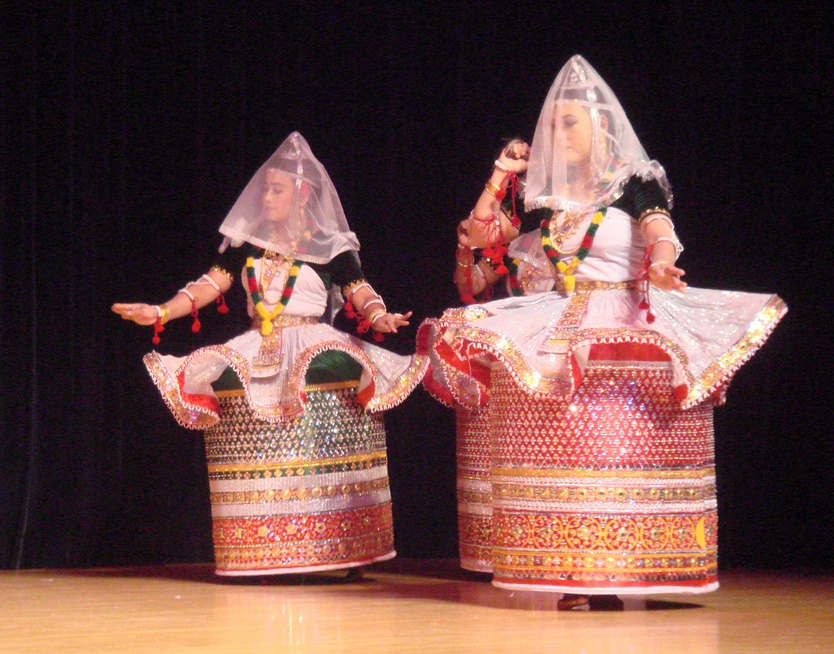
The mythological origin of Manipuri dance is traced to the celestial dance of Shiva and Parvati along with ‘Gandharva in the valley of Manipur. The dance gained prominence after the advent of Vaishnavism. Rabindra Nath Tagore introduced it in Shantiniketan thereby brought back the prominence of this dance form in modern times. Manipuri emphasis on devotion. It incorporates both Tandava and Lasya in which more emphasis is given to Lasya.
The body connected through curves in the shape of ‘8’ called Nagabhanda Mudra is an important feature of this dance form. Ras Leela is a recurring theme of Manipuri dance recital. Drums, flute, horns, esraj, tamboura, cymbals, and mridang are some of the important instruments used in Manipuri dance. Jhaveri sisters, Guru Bipin Singh, etc are the famous proponents of the Manipuri dance form.
Kathak: The Traditional Dance form of Uttar Pradesh

Kathak is the traditional dance form of Uttar Pradesh. Kathak derives its name from the ‘ Kathika’ or storyteller who recites verses from the epics with music and gestures. During the Mughal times, it was influenced by Islamic features, especially in costume and dancing style. Later in the twentieth century, Lady Leela Sokhey revived the classical style of Kathak.
It is commonly identified with the court tradition in North India. In the technique, Kathak follows Vertical lines with no breaks and deflection. Footwork is very important in the training of dancers. Kathak is based on Hindustani music. It consists of different Gharanas like Lucknow, Jaipur, Raigarh, and Banaras. Jugalbandi is one of the main features of Kathak recital. It shows a competitive play between dancer and tabla player.
Gatbhaar is the dance without music or chanting. Mythological episodes are outlined by this. Kathak is accompanied by dhrupad music. During the Mughal period, Taranis, Thumris, and Ghazals were introduced. Lachha Maharaj, Shambu Maharaj, and Birju Maharaj, etc are the main proponents of Kathak.
Sattriya: The Devotion dance form
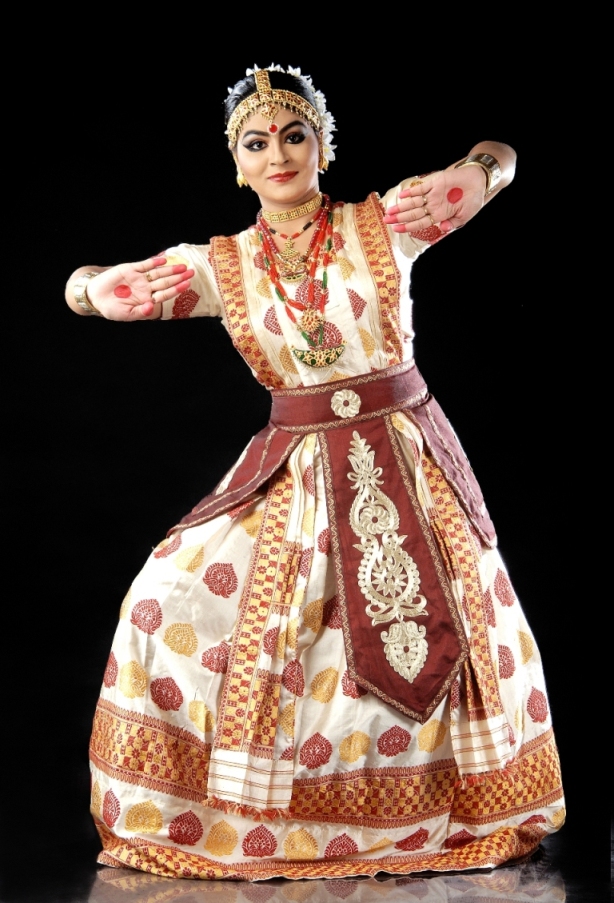
In the 15th century AD, Vaishnava saint of Assam, Shankaradeva introduced the Sattriya form of dance. Sattriya derives its name from the Vaishnava Monastries Known as Sattras. It focuses more on the devotional aspect of dance; it narrates the mythological stories of Vishnu.
The dance form is performed in a group by male monks known as Bhokots as part of their daily rituals. Khol and Flute are the main instruments played in Sattriya dance. Rhythmic syllables and dance postures along with footwork have given greater emphasis in Sattriya dance. It combines the elements of Lasya and Tandava. There is a strict guideline laid down for the hand gestures and footwork in Sattriya dance. Gayan-Bhayanar Nach and Kharmanar Nach are two streams that evolved in modern times.
Chakyar Koothu: Probable dance form from Aryan

This dance form is believed to have been introduced to Kerala by the earlier Aryan immigrants. Its performance is restricted to the members of the Chakiar caste. It is a highly orthodox form of entertainment that is performed inside the temples and is witnessed by Hindus of the higher castes only.
Ottam Thullal: The Poor’s man Kathakali

It is also a solo dance form of Kerala, known as poor man’s Kathakali. The dialogue is in simple Malayalam and therefore has a mass appeal. Kunjan Nambiar evolved it to bring out the social conditions of his time, the distinctions of class, and the whims and weaknesses of the rich.
Yakshagana

It is a dance-drama from Karnataka which is of rural origin. the language is Kannada and the theme based on the Hindu epics. It is about 400 years old. It was revived by Dr. Shivaram Karanth.

